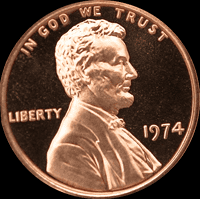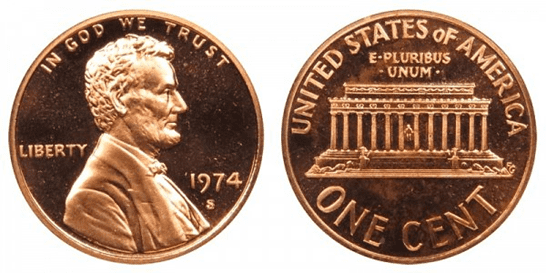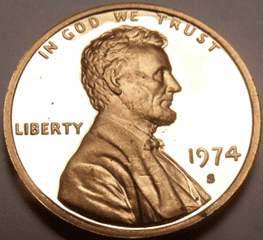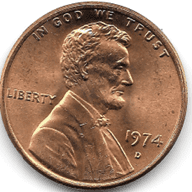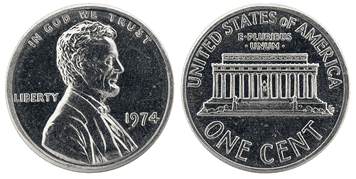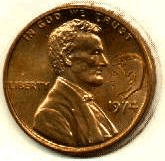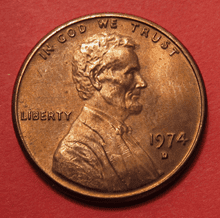How Rare Is A 1974 Penny?
One of the most appealing aspects of coins and coin collecting is that they can serve as a record of historical events that occurred during the year the piece was produced. They can also serve as a memento for a person born in that year, or who experienced a significant personal event during the time.
Speaking of significant events, 1974 was a pretty busy year for the US. Richard Nixon became the first US president forced to resign after the Watergate Scandal and was pardoned by his successor, Gerald Ford. The epic Rumble in the Jungle title fight between Muhammed Ali and George Forman fight took place, the Sears Tower in Chicago became the world’s tallest building, and in literature, Stephen King published his first novel, Carrie.
In terms of rarity, the standard 1974 Penny has little value, and can still be found in circulation today. The rarity of this coin comes from error coins and the controversial 1974 Aluminum Penny.
Contents
1974 Penny Series
1) 1974 Penny With No Mint Mark
Year: 1974
Face Value: $0.01
Composition: 95% copper, 5% zinc
Total Weight: 3.11 grams (or over)
Diameter: 0.750 in. 19.05 mm
Thickness: 0.0598 inches (1.52 mm)
Edge: Plain
Minted in: Philadelphia
Quantity Minted : 4,103,183,000

photo source: cointrackers.com
It’s worth noting here that there was also a 1974 No Mintmark, West Point coin that was indistinguishable from the Philadelphia 1974 penny and of these were 128,957,523 minted.
2) 1974 S Penny
Year: 1974
Face Value: $0.01
Composition: 95% copper, 5% zinc
Total Weight: 3.11 grams (or over)
Diameter: 0.750 in. 19.05 mm
Thickness: 0.0598 inches (1.52 mm)
Edge: Plain
Minted in: San Francisco
Quantity Minted : 4,103,183,000

photo source: usacoinbook.com
3) 1974 S-proof, (Small Date)
Year: 1974
Face Value: $0.01
Composition: 95% copper, 5% zinc
Total Weight: 3.11 grams (or over)
Diameter: 0.750 in. 19.05 mm
Thickness: 0.0598 inches (1.52 mm)
Edge: Plain
Minted in: San Francisco
Quantity Minted : 2,612,568

photo source: www.ebay.co.uk
4) 1974 D Penny
Year: 1974
Face Value: $0.01
Composition: 95% copper, 5% zinc
Total Weight: 3.11 grams (or over)
Diameter: 0.750 in. 19.05 mm
Thickness: 0.0598 inches (1.52 mm)
Edge: Plain
Minted in: Denver
Quantity Minted : 4,235,098,000

photo source: www.ebay.co.uk
5) 1974 Aluminum Penny
Year: 1974
Face Value: $0.01
Composition: 95% copper, 5% zinc
Total Weight: 3.11 grams (or over)
Diameter: 0.750 in. 19.05 mm
Thickness: 0.0598 inches (1.52 mm)
Edge: Plain
Minted in: Philadelphia
Quantity Minted : Unknown mintage of approximately 1.5 million

photo source: coinweek.com
6) 1974 Double Headed Penny

photo source: www.cointalk.com
While you may initially believe that this coin is an ultra-rare error, it is actually counter-stamped by a third party after minting and offered as a novelty to collectors.It has little or no numismatic value. However, counter-stamped coins, are interesting to collect and reflect an interesting period in coin history.
7)1974 Doubled Die Obverse D-Penny
Year: 1974
Face Value: $0.01
Composition: 95% copper, 5% zinc
Total Weight: 3.11 grams (or over)
Diameter: 0.750 in. 19.05 mm
Thickness: 0.0598 inches (1.52 mm)
Edge: Plain
Minted in: Denver
Quantity Minted : Error coin, unknown mintage quanitity

photo source: www.coincommunity.com
How Much Is A 1974 Penny Worth Today?
Listed below are the expected mintage numbers and values of the various types of 1974 Lincoln penny. The prices listed are highly dependent on condition and grade. Factors which impact the value of coins include the official grading given, circulation numbers, any unique elements about the coin (such as errors), the overall condition and wear, and whether or not the coin was actively used in circulation.
| Coin | Mintage | Value (Dependent on Grade) |
| 1974 No Mintmark (Philadelphia) | 4,103,183,000 | 20-25c + (Same for Westpoint Penny) |
| 1974-D (Denver) | 4,235,098,000 | 20-25c + |
| 1974-S (San Francisco) | 409,426,660 | 20-25c + |
| 1974-S Proof | 2,612,568 | $1 + |
| 1974 Aluminum Penny | 1.5million (estimated) | $200,000+ (illegal to sell) |
| 1974 Doubled Die Obverse Penny | Unknown | $400+ |
Why Is It Illegal To Own A 1974 Aluminum Penny?
Let’s talk about the infamous 1974 silver penny. Family, friends, and other coin collectors are likely to have told you about the 1974 silver pennies. Some individuals use the word “silver penny” whimsically as if Mint officials manufactured unusual silver pennies on purpose, but these silver-toned coins are in fact made out of humble aluminum.
While there are several off-metal error coins involving silver dime planchets that made their way into the Lincoln cent presses (these errors are worth more than $100 each), the United States Mint never created any 1974 silver pennies on purpose.
So, why did the Mint bother to produce aluminum pennies in 1974? In 1974, the Mint issued aluminum cents as a test currency. Due to the rising cost of copper, they were created to assist in lowering the cost of striking copper pennies.
Copper prices had climbed from 50 cents per pound to about $1 in the early 1970s. That meant that the melt value of copper in a normal Lincoln penny was roughly equal to the coin’s face value (and in fact, some years of copper penny are worth double their face value).
That also meant that the cost of producing a Lincoln cent was approaching the face value – a circumstance that still exists today, when each penny costs around 1.5 cents to produce, resulting in a loss to taxpayers with every 1-cent coin produced.
To assist cut the cost of producing pennies, the United States Mint began experimenting with new materials. Government officials eventually chose aluminum as the option, and the Mint produced more than 1 million 1974 aluminum pennies to test the new coin.
It turned out the new coin wasn’t well-received. Some paediatricians were afraid that ingested aluminum pennies might not show up on x-rays. At the same time, vending machine operators objected to the cost of upgrading their machines to accept aluminum pennies.
Luckily, this test period was short-lived as copper prices dropped, so the Mint was relieved of the need to replace the copper-based alloy in the penny.
More than 1 million pieces of the 1974 aluminum cent were destroyed, including hundreds presented to members of Congress and other dignitaries. However, not all of the coins were returned, and an unknown (small) number of 1974 aluminum pennies remain unaccounted for today.
The Legal Consequences of Owning a 1974 Aluminum Penny
All 1974 aluminum pennies are classified as government property, making them illegal to possess. This means the legal consequences of knowingly owning and trying to sell an aluminum penny could be dire, and all examples of the coin should be surrendered to the appropriate parties.
The most notable case featuring the 1974 Aluminum penny came in 2014 when the federal government was sued by Randall Lawrence, the son of a former Mint officer, and Michael McConnell, the owner of a coin shop in the San Diego area after it requested the return of the cent.
Lawrence and McConnell had planned to exhibit the coin at various exhibits across the country before selling it at an auction house for up to $2 million, but the rare coin was seized before this could take place.
While a $2 million estimate certainly is exciting, we won’t know the true worth of these rare pennies until the 1974 aluminum penny becomes legal to acquire.
How To Tell If 1974 Penny Is Aluminum
To tell if you have a 1974 aluminum penny — or one that appears to be composed of a silvery metal you’ll need to weigh your coin. The weight of a 1974 aluminum penny is far lighter than the copper penny due to aluminum’s lightweight characteristics and therefore weighs approximately 0.93 grams.
You have a standard copper cent with some form of silvery metal plating if your 1974 penny weighs 3.11 grams (or higher). These are popular novelty coins that have been altered after leaving the United States Mint and can be legally owned and sold.
How Coins are Graded
The Sheldon Scale is used by numismatists to provide a numerical value to coins. The Sheldon Scale goes from poor (P-1) to perfect mint state (P-1) (MS-70). Coins were originally evaluated using words to reflect their condition (Good, Fair, Excellent, Etc.). Unfortunately, coin collectors and dealers had different ideas about what each of these terms represent.
Professional numismatists joined together in the 1970s and established CoinGrading standards. These numismatists now assign grades at key places on the seventy-point scale, using the most regularly utilized numeric points in conjunction with the original adjective grade. The following are the most common coin grades:
-
-
- (P-1) Poor – Indistinguishable and probably damaged; if used, must have a date and mintmark; otherwise, rather battered.
- (FR-2) Fair – Nearly smooth, but without the damage that a coin graded Poor often possesses. The coin must have enough detail to be identified.
- (G-4) Fair – Inscriptions have merged into the rims in some areas, and important elements have been mostly erased.
- (VG-8) Very Good- A little weathered, but all of the primary design elements are visible, albeit faintly. There is little if any, central detail left.
- (F-12) Good – The item is very worn, yet the wear is even, and the overall design details stand out clearly. Rims are almost completely isolated from the field.
- (VF-20) Very Fine – Moderately weathered, with some finer features still visible. The motto or all letters of LIBERTY are readable. Both sides of the coin have entire rims that are separated from the field.
- (EF-40) Extremely Fine – Gently used; all gadgets are visible, and the most important ones are bold. The finer details are bold and clear, however, light wear may be seen.
- (AU-50) Uncirculated – Slight evidence of wear on the coin’s design’s high points; may have contact marks; eye appeal should be adequate.
- (AU-58) Uncirculated Choice – Slight traces of wear, no severe contact marks, almost full mint shine, and great eye appeal.
- (MS-60) Mint State Basal – Strictly uncirculated; no indication of wear on the coin’s highest points, but an unsightly coin with reduced luster, visible contact marks, hairlines, and other flaws.
- (MS-63) Mint State Acceptable – Uncirculated, but with contact scratches and nicks, little reduced shine, but otherwise appealing appearance. The strike is weak to average.
- (MS-65) Mint State Choice – Uncirculated with great mint shine, very little contact blemishes, and exceptional eye appeal. The strike is unusually severe.
- (MS-68) Mint State Premium Quality – Uncirculated with superb luster, no obvious contact marks to the naked eye, and exceptional eye appeal. The strike is quick and appealing.
- (MS-69) Almost Perfect Mint State – Uncirculated with perfect brilliance, a sharp and appealing strike, and extremely good eye appeal. A near-perfect coin with minor imperfections in the planchet, strike, and contact markings (seen only under 8x magnification).
- (MS-70) Mint State Perfect – Under 8x magnification, there are no tiny imperfections discernible; the strike is crisp, and the coin is perfectly centered on a beautiful planchet. Rarely seen on a coin, this coin is bright and whole, with original luster and exceptional eye appeal.
-
Where To Buy Or Sell 1974 Pennies?
Currency Converters
Unlike more rare coins, as Lincoln Pennies are still in regular circulation, you’re more likely to come across them in your day to day life. As the value of most examples of this coin is low, selling individual Lincoln Pennies online can be a struggle which is why one of the best options for selling low-value vintage coins is to use a currency converter such as Foreign Currency and Coin and Leftover Currency.
Online Marketplaces
Online Marketplaces such as eBay are probably your best option when it comes to purchasing a 1974 Lincoln Penny directly, and can cost around $2 for the most regular type.
Specialist Dealers, Forums, and Auction Houses
For more rare examples of this Penny, mostly error types, visiting specialist dealers, online forums, and auction houses give buyers and sellers peace of mind and come with the added bonus that the coins for sale have already been graded. Remember, if you come across an aluminum Lincoln penny you must surrender the coin to the government.
FAQs
How many 1974 aluminum pennies were made?
Numbers for the mintage of 1974 aluminum pennies are unclear, but it is estimated that around 1.5million of these coins were minted. As most of these coins were surrendered and destroyed, it’s unclear how many of these coins are still in private hands.
Where can you see the mint mark on a 1974 penny?
The mint mark on the 1974 Lincoln penny is found below the date on the coin to the right of Lincoln’s chest.

